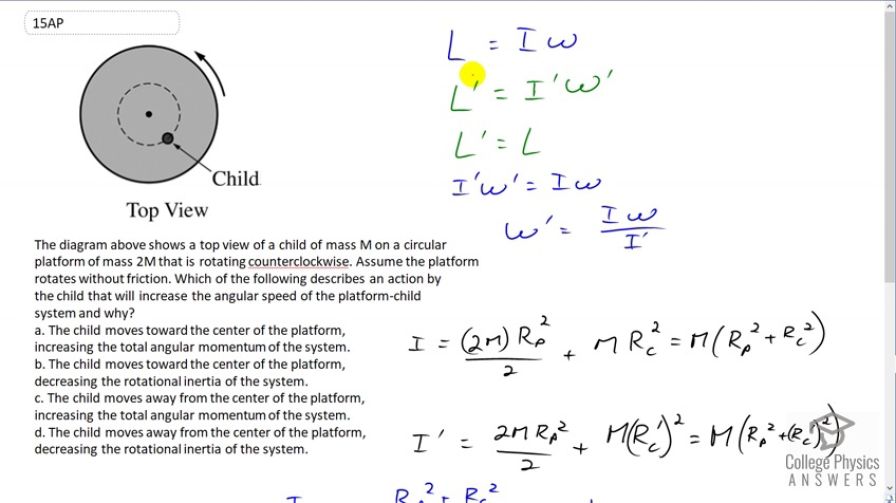Question
The diagram below shows a top view of a child of mass M on a circular platform of mass 2M that is rotating counterclockwise. Assume the platform rotates without friction. Which of the following describes an action by the child that will increase the angular speed of the platform- child system and why?
- The child moves toward the center of the platform, increasing the total angular momentum of the system.
- The child moves toward the center of the platform, decreasing the rotational inertia of the system.
- The child moves away from the center of the platform, increasing the total angular momentum of the system.
- The child moves away from the center of the platform, decreasing the rotational inertia of the system.
Final Answer
(b)
Solution video
OpenStax College Physics for AP® Courses, Chapter 10, Problem 15 (Test Prep for AP® Courses)

vote with a rating of
votes with an average rating of
.
Video Transcript
This is College Physics Answers with Shaun Dychko. In this system with a child on a spinning disk we know that the angular momentum is not going to change as the child moves either towards or away from the axis of rotation because there is no external force acting on the system so angular momentum is conserved. So initially at this initial position of the child, the angular momentum is the moment of inertia of the system, multiplied by its angular velocity. Then after the child moves, and we don't know yet which direction the child should move, be it towards the axis of rotation or away, but whatever their movement is, their angular momentum after they move will be the new moment of inertia multiplied by the new angular velocity. We can say that these two angular momenta are equal to each other, so angular momentum is conserved in other words. So we can equate i prime, omega prime to i omega and then solve for omega prime. Now, we're doing this because the question says "describe an action such that the angular speed increases" and so we now have a formula for the angular speed. So we'll see where in this equation is something that describes the child's movement. It's the moment of inertia that's going to be affected by the child. So let's create expressions for moment of inertia before and after the child moves to see where the child's position becomes a parameter in this moment of inertia. So the moment of inertia will be the platform's moment of inertia plus the moment of inertia of the child. So the platform is the disk of mass two m and we multiply by its radius squared and divide by two. That's the formula for the moment of inertia of a spinning disk. Then the child will model as a point mass a distance R c so radius of the child from the axis of rotation, squared, multiplied by the child's mass which we're told is m. We can cancel the two's here and factor out the m. We get m times bracket R p squared plus R c squared. After the child moves, the only thing that's different is that we have an R c prime here so this is the radius of the child prime, and the prime denotes after the child has moved. The algebra's the same and we get m times R p squared plus R c prime squared. Now, when we're talking about the angular velocity after the child moves, it equals this ratio of i to i prime multiplied by the original angular velocity. So if i over i prime is some number greater than one, then we will increase the angular velocity and that's what we're told that we have to do. So we're going to substitute expressions that we have over here in for i and we cancel the m by the way, I didn't show that, but it's m multiplied by both of these numerators and denominators and they cancel. This has to be greater than one in order for omega prime to be greater than omega. Then we have an inequality and we'll solve this to get a relationship between R c and R c prime. We can multiply both sides by this denominator, so multiply both sides by R p squared plus R c prime squared. On the right side you should get that expression and on the left side the denominator cancels with that. We have this line here and then we can subtract R p squared from both sides. We get R c squared is greater than R c prime squared and then take the square root of both sides. You have the R c has to be greater than R c prime. So this is our conclusion for how the radius should change such that the angular velocity will then be greater than the original angular velocity. So the radius of the child afterwards has to be less than the radius initially, or written a different way is to say that the original radius of the child on the axis of rotation has to be greater than the radius of the child afterwards. So the child has to move towards the axis of rotation. Doing so will decrease the moment of inertia and so the answer is B. So we have the child moving towards the center of the platform -- decreasing the rotational inertias is the way they said it, and that's fine too. Part A also has the child moving towards the center but there is no change in angular momentum. The angular momentum is conserved and so B is the answer here.